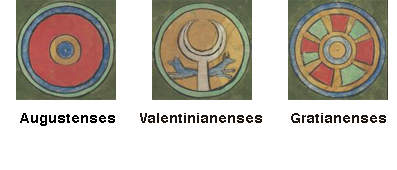
This page created 13 September 2014, and last modified: 26 July 2015 (Maier reference numbers added)

The 19th of the units listed (18.30 in Ingo Maier's numbering scheme) under the heading (18.11) "legiones comitatenses" in the section of the Magister Militum per Thracias is the Augustenses. Its shield pattern (17#14) as shown in various manuscripts, under the matching label (17.o) Augustenses, is as below:

The pattern is relatively simple, having a blue boss (white in B) encircled by a yellow band. The main field is red, and edged with a blue band and then a green rim (faded to yellow in M, and white in W).
Although the Augustenses is the second-last of the units listed under the command of the Magister Militum per Thracias, it is only the the third-last illustrated as such, since the Valentinianenses, the last unit listed (18.31), is followed on the illustrations page by the Gratianenses (14#16; 14.q), whose omission from the Magister's list (18.30.1) is perhaps inadvertent, since, as Jones says (page 348), the Gratianenses would appear to be one of three related units: the Augustenses (referring to the eastern Augustus, Valens), the Valentinianenses (after his elder brother Valentinian I, the western Augustus), and the Gratianenses (after Valentinian I's son Gratian, the Caesar), raised and serving together; it is always a possibility, however the units were merely "rebranded" with new names rather than being newly raised. The shield patterns of the three units, despite their related names and being in the same command, are not at all similar, as a comparison of the following patterns taken from the Parisian manuscript shows:

Although the number of units named after Valentinian I in the Notitia is not huge (less than a dozen), they certainly outnumber those named after his brother Valens, who appears to have just a single unit directly and clearly named after him: the Tertii sagittarii Valentis (9.31, but see my discussion of the Sagittarii dominici, 12.30; and see also the Secunda Felix Valentis Thebaeorum, 15.23). Of course, it is possible other units may be indirectly named after him in the manner of the Augustenses; other units in the Notitia bearing the same name include a limitanei unit (137.9) under the Dux Mauritania, but this is likely a detachment of the Tertio Augustani (98/9.128), one of the legiones comitatenses under the Comes Africae, and thus named after the original emperor Augustus; and an auxiliary unit (141.21) under the Dux Pannoniae secundae, which might possibly be the origin of the similarly-named Augustei (98/9.58), a unit of auxilia palatina listed in the western Magister Peditum's infantry roster, but not apparently assigned to any field command.
Since all the infantry units listed under the Magister Militum per Thracias come under the heading (18.11) "legiones comitatenses", one would expect the Augustenses to also be a legionary unit; however, this would make the Thracian field force unique in being the only one without any auxilia palatina units, or pseudocomitenses auxilia units for that matter. However, all may not be what it seems. In the Magister Militum per Orientem's list, the two auxilia palatina units there are not actually listed separately as such, but appear under the heading (15.2) "Vexillationes comitatenses", i.e. as cavalry units. Further, the pseudocomitatenses units are also enumerated differently in most manuscripts from what is actually listed. Thus a similar situation may well apply to the Magister Militum per Thracias.
In favour of this, I would posit the Augustenses, the Valentinianenses, and the Gratianenses were actually auxilia units: their names to me resemble those of auxilia (especially auxilia palatina) units more than they do legionary units. A further indication of auxiliary status is the twin-headed (pseudo-) zoomorphic device of the Valentinianenses, which, counting both headless and non-headless variants, is carried by 15 units, of which none are legionary, save the potential example of the Valentinianenses. Perhaps these three units, raised together, were added as an illustrated block at the end of the list for simplicity rather than being inserted in the usual place for auxilia palatina (i.e. before the legiones comintatenses), since that would require rewriting (and redrawing) the document. Alternatively, they may simply had not been given auxilia palatina status, and instead have been pseudocomitatenses auxiliary units, in which case they would be correctly positioned, and the only "problem" would be the then relatively minor one of a line labelling them as such (e.g. 18.29.1 Pseudocomitatenses) being missing. This would also have the added bonus of making the textual omission of the Gratianenses perhaps less surprising. (It may be that the Gratianenses was simply soon removed from the command; this would leave an even number of infantry units, which seems to have been the typical pattern, so as to allow the brigading of units together in pairs.)

Return to the Notitia alphabetical unit list page.
Return to my Notitia index page.